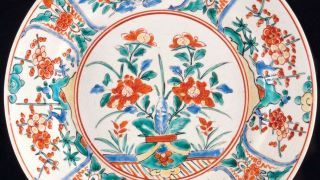Beautiful Imari porcelain
On the AnArt4Life Blog we have produced a number of posts on ceramics of different kinds. They can all be found under the Ceramics tab in the TagCloud on the website. Many of those posts were about well-known British Staffordshire brands originating from the Stoke-On-Trent area.
But today I would like to give you an overview of a respected Japanese porcelain called Imari ware or Arita ware. (In a previous post we looked at the differences between earthenware, stoneware and porcelain (click here.)



Porcelain first appeared during the 7th century in China, where the ingredients and processes were kept secret for a long time. In Japan, however, the production of porcelain began quite some time later, in the early 17th century. The reason for the late start compared to the Chinese is that the kaolin-rich clay (needed for the production of porcelain) was not discovered in Japan until the early 17th century in the Arita area, ironically by Korean potters.1
Europe had developed quite a taste for all things Chinese, especially silk, spices and porcelain. Its appetite was fed by the prosperous Vereenigde Oostindische Compagnie “VOC”, (the Dutch East Indies Company, but officially called the United East Indies Company). It was the first multinational company to link East and West by sailing the world seas for trade – the first form of globalisation!



You may know of the harsh Sakoku, the period of seclusion under the "closed door" policy ordered by the Tokugawa shogunate in 1638. This stopped all Japan's interactions with the West and completely isolated its people for over 200 years. However, the Dutch were permitted to continue to trade, but ONLY by transferring all of their trade operations to the small man-made island of Dejima in Nagasaki harbor. The island had been built for the Portuguese, but they had been forced to abandon it and all contacts with Japan. The Dutch presence in Japan was closely monitored and controlled, but they were allowed in.2
However, when the Ming Dynasty fell in the late 17th century the pottery kilns fell silent for some 60 years or so. The Dutch East India Company needed an alternative source of import to meet the rising demand of Imari Porcelain in the West, and so began started exporting Japanese porcelain.
Both the Chinese and Japanese versions of porcelain were known as Imari ware as they were exported from the seaport of Imari, on the island Kyushu, Saga, in the south-west of Japan. The two islands of Taka and Fuku in the bay form a natural mole, protecting the city’s harbour, making it an ideal trade port. The porcelain is also known as Arita ware as this where it is produced, some 10 km south of the Imari port.



"Early Imari" (shoki imari) were made around Arita before about 1650. The porcelains are generally small and sparsely painted in underglaze blue for the domestic market.2

Chinese Imari is typically characterized by a combination of blue, red and gold. Details are sometimes in black and green enamels and the porcelain tends to be whiter and brighter than its Japanese counterpart. You can often find typical Chinese motifs, and the use of red and gold, which makes Chinese Imari more lavish than Japanese. Frequent motifs are landscapes, flowers, plants, birds and mythical creatures. Portrayals of human figures are less frequent. Chinese Imari is also known to have a thinner glaze and to be more finely potted.3
Japanese Imari is also characterized by its colourful elaborate style, often featuring white and blue backgrounds, accented with a fuller, more dark red on top.3
Typically Imari ware is decorated in underglaze blue, with red, gold, black for outlines, and sometimes other colours, added in overglaze. Some of the most characteristic floral designs have been said to have "a tendency to overdecoration that leads to fussiness," 2 ...... but I like them very much. What do you think?






Imari ware is still produced today and is highly prized and sought-after as a valuable collectable.
Footnotes
With thanks to
- Britannica.com
- Wikipedia.com
- Bellamys world.com
